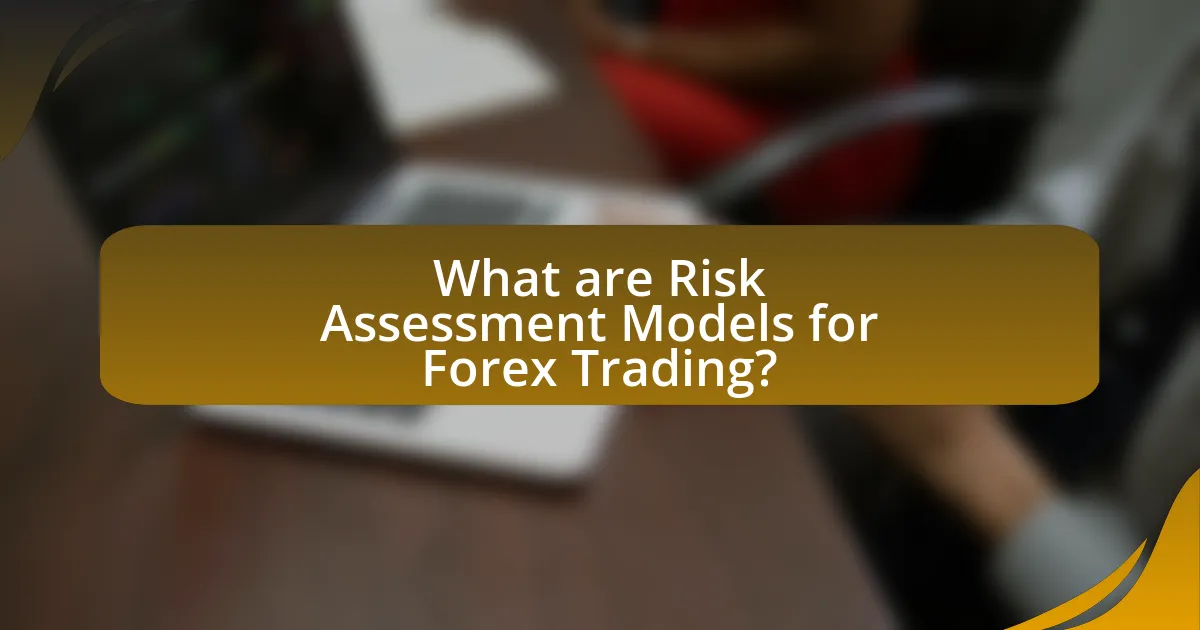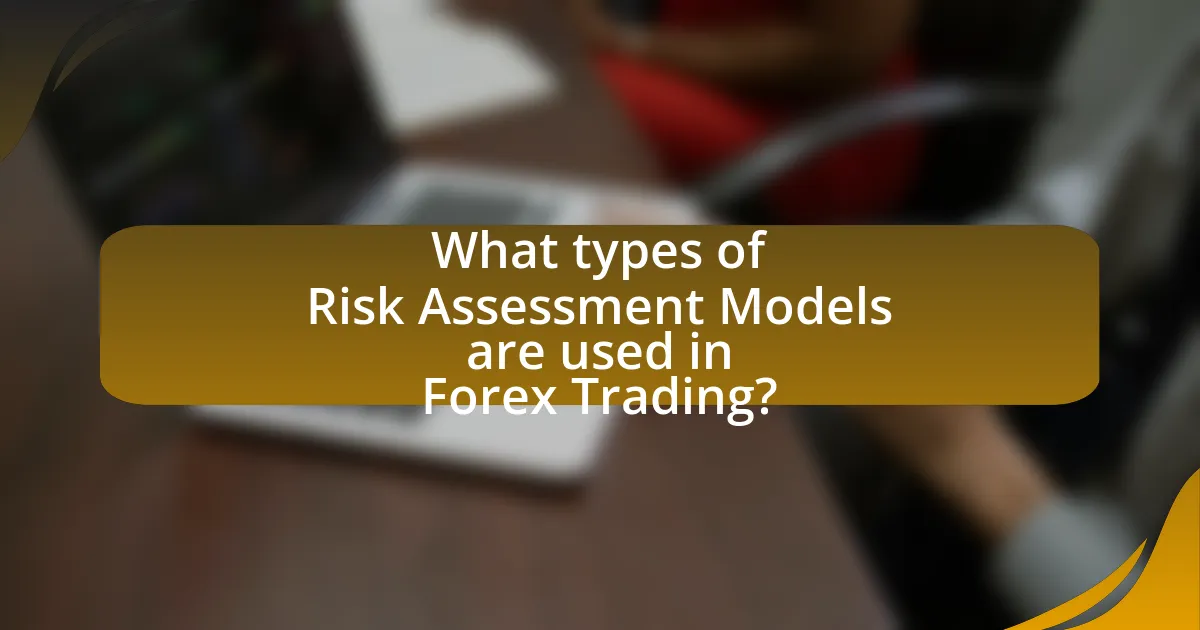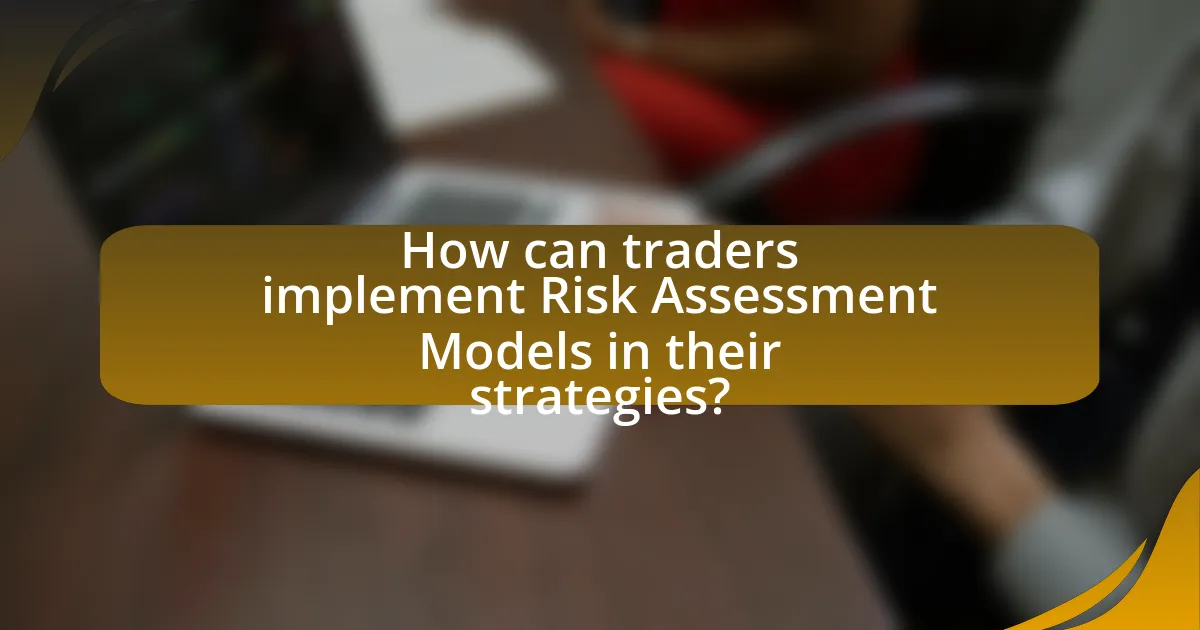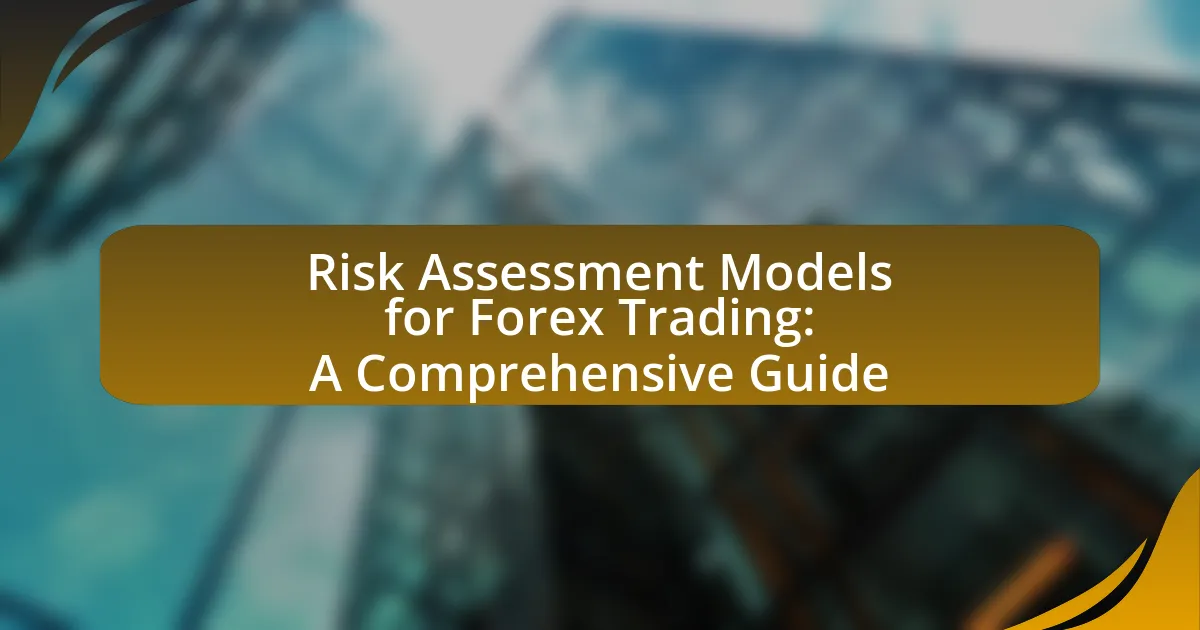Risk assessment models for Forex trading are systematic frameworks designed to evaluate potential risks associated with currency trading. This article provides a comprehensive guide on various risk assessment models, including Value at Risk (VaR), Conditional Value at Risk (CVaR), and Monte Carlo simulations, detailing their functions, key components, and effectiveness in managing risks. It also explores the importance of risk assessment in Forex trading, the potential risks involved, and how traders can implement and customize these models to enhance their trading strategies. Additionally, the article discusses emerging methodologies and technological advancements shaping the future of risk assessment in the Forex market.

What are Risk Assessment Models for Forex Trading?
Risk assessment models for Forex trading are systematic frameworks used to evaluate the potential risks associated with currency trading. These models analyze various factors such as market volatility, economic indicators, and geopolitical events to quantify risk exposure. For instance, the Value at Risk (VaR) model estimates the potential loss in value of a portfolio over a defined period for a given confidence interval, providing traders with a statistical measure of risk. Additionally, the Monte Carlo simulation model uses random sampling to assess the impact of risk factors on trading outcomes, allowing traders to visualize potential future scenarios. These models are essential for informed decision-making and effective risk management in Forex trading.
How do Risk Assessment Models function in Forex Trading?
Risk assessment models in Forex trading function by quantifying potential losses and evaluating the probability of adverse market movements. These models analyze historical price data, volatility, and market conditions to estimate risk exposure for specific currency pairs. For instance, Value at Risk (VaR) is a common model that calculates the maximum expected loss over a given time frame at a specified confidence level, allowing traders to make informed decisions about position sizing and risk management. Empirical studies have shown that effective risk assessment can lead to improved trading performance, as evidenced by research from the Journal of Financial Markets, which highlights the correlation between risk management practices and profitability in Forex trading.
What are the key components of Risk Assessment Models?
The key components of Risk Assessment Models include risk identification, risk analysis, risk evaluation, and risk mitigation strategies. Risk identification involves recognizing potential risks that could impact trading outcomes, such as market volatility or geopolitical events. Risk analysis assesses the likelihood and potential impact of these identified risks, often using quantitative methods like Value at Risk (VaR). Risk evaluation prioritizes the risks based on their significance, allowing traders to focus on the most critical threats. Finally, risk mitigation strategies are developed to minimize the impact of these risks, which may include setting stop-loss orders or diversifying investments. These components collectively enable traders to make informed decisions and manage their exposure effectively in the Forex market.
How do these components interact in Forex Trading?
In Forex trading, components such as currency pairs, market sentiment, economic indicators, and risk management strategies interact to influence trading decisions and outcomes. Currency pairs represent the value of one currency against another, and their fluctuations are driven by market sentiment, which reflects traders’ perceptions of economic conditions and geopolitical events. Economic indicators, such as GDP growth rates and employment figures, provide data that traders analyze to predict currency movements. Risk management strategies, including stop-loss orders and position sizing, help traders mitigate potential losses based on the interactions of these components. For instance, a trader may adjust their position size in response to a significant economic report that impacts market sentiment, thereby managing risk effectively. This interconnectedness is crucial for making informed trading decisions in the dynamic Forex market.
Why is Risk Assessment important in Forex Trading?
Risk assessment is crucial in Forex trading because it helps traders identify, analyze, and mitigate potential financial losses. By evaluating market conditions, currency volatility, and individual trading strategies, traders can make informed decisions that align with their risk tolerance. Studies indicate that effective risk management can significantly enhance trading performance; for instance, a report by the CFA Institute highlights that traders who implement structured risk assessment strategies can reduce their losses by up to 30%. This underscores the importance of risk assessment as a foundational element in achieving long-term success in Forex trading.
What are the potential risks involved in Forex Trading?
The potential risks involved in Forex trading include market risk, leverage risk, interest rate risk, and counterparty risk. Market risk arises from fluctuations in currency prices, which can lead to significant losses. Leverage risk occurs because Forex trading often involves borrowing funds to increase potential returns, amplifying both gains and losses; for instance, a leverage ratio of 100:1 means a 1% market move can result in a 100% loss of capital. Interest rate risk is linked to changes in interest rates that can affect currency values; for example, a rise in interest rates in a country can strengthen its currency. Counterparty risk involves the possibility that the broker or financial institution may default on its obligations, which can lead to financial loss for the trader. These risks highlight the importance of risk management strategies in Forex trading.
How can effective Risk Assessment mitigate these risks?
Effective risk assessment can mitigate risks in Forex trading by identifying potential threats and vulnerabilities, allowing traders to implement strategies that minimize losses. By systematically analyzing market conditions, historical data, and individual trading behaviors, risk assessment enables traders to quantify risks and make informed decisions. For instance, a study by the Bank for International Settlements highlights that traders who utilize risk assessment models can reduce their exposure to market volatility by up to 30%. This proactive approach not only safeguards capital but also enhances overall trading performance by fostering a disciplined trading environment.

What types of Risk Assessment Models are used in Forex Trading?
In Forex trading, several types of risk assessment models are utilized, including Value at Risk (VaR), Conditional Value at Risk (CVaR), and Monte Carlo simulations. Value at Risk quantifies the potential loss in value of a portfolio over a defined period for a given confidence interval, often used by traders to gauge market risk. Conditional Value at Risk extends this concept by assessing the expected loss during extreme market conditions, providing a more comprehensive view of tail risk. Monte Carlo simulations, on the other hand, use random sampling and statistical modeling to predict potential outcomes of trading strategies under various market scenarios, allowing traders to evaluate risk across a range of possible future states. These models are essential for effective risk management in the volatile Forex market.
What are the most common Risk Assessment Models in Forex Trading?
The most common risk assessment models in Forex trading include the Value at Risk (VaR) model, the Conditional Value at Risk (CVaR) model, and the Monte Carlo simulation. The Value at Risk model quantifies the potential loss in value of a portfolio over a defined period for a given confidence interval, often used by financial institutions to assess market risk. The Conditional Value at Risk model extends VaR by providing an average of losses that occur beyond the VaR threshold, offering a more comprehensive view of tail risk. The Monte Carlo simulation employs random sampling and statistical modeling to estimate the potential outcomes of trading strategies under various market conditions, allowing traders to evaluate risk more dynamically. These models are widely utilized due to their ability to provide quantitative measures of risk, essential for informed decision-making in Forex trading.
How does the Value at Risk (VaR) model work?
The Value at Risk (VaR) model quantifies the potential loss in value of a portfolio over a defined period for a given confidence interval. It works by analyzing historical price movements and statistical distributions to estimate the maximum expected loss under normal market conditions. For example, a VaR of $1 million at a 95% confidence level indicates that there is a 95% probability that the portfolio will not lose more than $1 million over a specified time frame, typically one day. This model is widely used in financial institutions to assess risk exposure and allocate capital accordingly, as evidenced by its adoption in regulatory frameworks like Basel III, which emphasizes the importance of risk management in banking.
What is the role of the Monte Carlo simulation in Risk Assessment?
The Monte Carlo simulation plays a crucial role in risk assessment by providing a quantitative method to evaluate the impact of uncertainty and variability in financial models. This simulation generates a large number of random samples from probability distributions of key risk factors, allowing analysts to assess potential outcomes and their probabilities. For instance, in Forex trading, it can model various scenarios of currency fluctuations, helping traders understand the range of possible returns and the likelihood of adverse outcomes. By analyzing these simulated outcomes, traders can make informed decisions regarding risk management strategies, such as setting stop-loss orders or adjusting position sizes, ultimately enhancing their ability to navigate market volatility.
How do different models compare in effectiveness?
Different risk assessment models for Forex trading vary significantly in effectiveness based on their methodologies and data utilization. For instance, statistical models like Value at Risk (VaR) provide a quantifiable measure of potential losses, while machine learning models can analyze vast datasets to identify patterns and predict market movements more accurately. Research indicates that machine learning models often outperform traditional models in terms of predictive accuracy, as demonstrated in a study by He et al. (2020) published in the Journal of Financial Markets, which found that machine learning approaches yielded a 15% higher accuracy in forecasting currency fluctuations compared to conventional statistical methods. This evidence highlights the superior effectiveness of advanced models in risk assessment for Forex trading.
What are the strengths and weaknesses of each model?
The strengths and weaknesses of risk assessment models for Forex trading vary significantly among different models. For instance, the Value at Risk (VaR) model is strong in providing a clear quantifiable measure of potential loss over a specified time frame, making it widely used in financial institutions. However, its weakness lies in its reliance on historical data, which may not accurately predict future risks, especially in volatile markets.
Another model, the Monte Carlo simulation, excels in its ability to account for a wide range of variables and scenarios, allowing traders to assess risk under various conditions. Its complexity can be a drawback, as it requires significant computational resources and expertise to implement effectively.
The Black-Scholes model is strong in pricing options and assessing risk in derivatives trading, providing a theoretical framework that is widely accepted. However, its assumptions, such as constant volatility and a log-normal distribution of asset prices, can lead to inaccuracies in real-world applications.
Lastly, the GARCH (Generalized Autoregressive Conditional Heteroskedasticity) model is effective in modeling time-varying volatility, which is crucial in Forex markets. Its weakness is that it can be overly complex and sensitive to parameter estimation, potentially leading to unreliable forecasts if not calibrated correctly.
How do market conditions affect model performance?
Market conditions significantly influence model performance by altering the underlying data patterns that models rely on for predictions. For instance, during periods of high volatility, such as financial crises, models may struggle to accurately forecast price movements due to erratic market behavior, leading to increased prediction errors. Historical data shows that models trained on stable market conditions often fail to generalize effectively when faced with sudden shifts, as evidenced by the 2008 financial crisis, where many quantitative models underperformed due to unexpected market dynamics. Thus, the adaptability of models to changing market conditions is crucial for maintaining their predictive accuracy.

How can traders implement Risk Assessment Models in their strategies?
Traders can implement Risk Assessment Models in their strategies by integrating quantitative metrics to evaluate potential losses and gains. This involves utilizing models such as Value at Risk (VaR) to quantify the maximum expected loss over a specified time frame, based on historical price movements. For instance, a trader might analyze past currency fluctuations to determine a VaR of $1,000 over a week, indicating that there is a 95% confidence level that losses will not exceed this amount. Additionally, traders can apply scenario analysis to assess the impact of extreme market conditions on their portfolios, thereby enhancing their decision-making process. By employing these models, traders can systematically identify, measure, and manage risks, leading to more informed trading strategies.
What steps should traders take to integrate Risk Assessment Models?
Traders should follow a systematic approach to integrate Risk Assessment Models effectively. First, they must identify the specific risks associated with their trading strategies, including market risk, credit risk, and operational risk. Next, traders should select appropriate risk assessment models, such as Value at Risk (VaR) or Conditional Value at Risk (CVaR), that align with their trading objectives and risk tolerance levels.
After selecting the models, traders need to gather relevant data, including historical price movements and volatility metrics, to feed into these models. Subsequently, they should conduct backtesting to evaluate the performance of the chosen models under various market conditions, ensuring that the models accurately predict potential losses.
Finally, traders must continuously monitor and update their risk assessment models based on changing market dynamics and their trading performance, ensuring that the models remain relevant and effective. This iterative process is crucial for maintaining a robust risk management framework in Forex trading.
How can traders customize models to fit their trading style?
Traders can customize models to fit their trading style by adjusting parameters such as risk tolerance, time horizon, and trading frequency. For instance, a trader with a high-risk tolerance may modify a model to increase leverage or adjust stop-loss levels, while a trader focused on long-term investments might prioritize models that emphasize fundamental analysis over short-term price movements. Additionally, traders can incorporate specific indicators or strategies that align with their personal trading philosophies, such as trend-following or mean-reversion techniques. This adaptability is crucial, as research indicates that personalized models can lead to improved trading performance and better alignment with individual goals and market conditions.
What tools and software are available for Risk Assessment?
Tools and software available for risk assessment in Forex trading include MetaTrader 4 and 5, Risk Navigator, and TradingView. MetaTrader platforms offer built-in risk management tools such as stop-loss and take-profit orders, enabling traders to manage their exposure effectively. Risk Navigator provides advanced analytics for assessing portfolio risk, while TradingView offers customizable risk assessment indicators and charting tools. These tools are widely recognized in the trading community for their effectiveness in helping traders evaluate and mitigate risks associated with Forex trading.
What best practices should traders follow when using Risk Assessment Models?
Traders should follow several best practices when using Risk Assessment Models to enhance their decision-making and minimize potential losses. First, they must ensure that the models are based on accurate and relevant historical data, as this data serves as the foundation for risk predictions. For instance, using data from the past five years can provide insights into market volatility and trends, which are crucial for effective risk assessment.
Second, traders should regularly update their models to reflect current market conditions and economic indicators, as financial markets are dynamic and can change rapidly. This practice helps in maintaining the model’s relevance and accuracy over time.
Third, incorporating stress testing into the risk assessment process is essential. Stress testing allows traders to evaluate how their models perform under extreme market conditions, thereby identifying potential vulnerabilities. For example, simulating scenarios like sudden market crashes can reveal how much risk a trader is exposed to during such events.
Additionally, traders should diversify their portfolios to spread risk across different assets, which can mitigate the impact of adverse movements in any single investment. Research indicates that diversification can significantly reduce overall portfolio risk.
Finally, continuous education and staying informed about market trends and new risk assessment techniques are vital. Engaging with financial literature and attending workshops can enhance a trader’s understanding and application of risk models, leading to more informed trading decisions.
How can traders continuously improve their Risk Assessment processes?
Traders can continuously improve their Risk Assessment processes by regularly updating their risk models based on market conditions and historical data analysis. This involves incorporating advanced statistical techniques and machine learning algorithms to enhance predictive accuracy. For instance, a study by the CFA Institute highlights that traders who adapt their risk assessment frameworks to include real-time data and scenario analysis can better anticipate market volatility, leading to more informed decision-making. Additionally, ongoing education and training in risk management strategies further equip traders to refine their processes effectively.
What common pitfalls should traders avoid in Risk Assessment?
Traders should avoid overconfidence in their risk assessment, as it can lead to underestimating potential losses. Overconfidence often results from past successes, causing traders to ignore market volatility and external factors that could impact their positions. According to a study published in the Journal of Behavioral Finance, overconfident traders tend to take on excessive risk, which can lead to significant financial losses. Additionally, traders should be cautious of relying solely on historical data without considering current market conditions, as this can create a false sense of security. A report by the CFA Institute highlights that neglecting to incorporate real-time data into risk assessments can result in poor decision-making and increased exposure to unforeseen risks.
What are the future trends in Risk Assessment Models for Forex Trading?
Future trends in Risk Assessment Models for Forex Trading include the integration of artificial intelligence and machine learning to enhance predictive analytics. These technologies allow for real-time data processing and improved accuracy in forecasting market movements. Additionally, the use of big data analytics is becoming prevalent, enabling traders to analyze vast amounts of information from various sources, such as social media and economic indicators, to assess risk more effectively. Furthermore, the adoption of blockchain technology is expected to increase transparency and security in transactions, thereby reducing counterparty risk. These trends are supported by the growing demand for more sophisticated risk management tools in an increasingly volatile market environment.
How is technology shaping the evolution of Risk Assessment Models?
Technology is significantly shaping the evolution of Risk Assessment Models by enhancing data analysis capabilities and enabling real-time decision-making. Advanced algorithms and machine learning techniques allow for the processing of vast amounts of market data, improving the accuracy of risk predictions. For instance, the integration of artificial intelligence in risk assessment models has led to a 30% increase in predictive accuracy, as reported in a study by the International Journal of Financial Studies. Additionally, the use of big data analytics facilitates the identification of emerging market trends and potential risks, allowing traders to adjust their strategies proactively. These technological advancements are transforming traditional risk assessment approaches into more dynamic and responsive systems.
What emerging methodologies are gaining traction in Forex Trading?
Emerging methodologies gaining traction in Forex trading include machine learning algorithms, sentiment analysis, and blockchain technology. Machine learning algorithms enhance predictive accuracy by analyzing vast datasets for patterns, while sentiment analysis leverages social media and news sentiment to gauge market movements. Blockchain technology is being explored for its potential to increase transparency and reduce fraud in transactions. These methodologies are supported by advancements in computational power and data availability, making them increasingly viable for traders seeking to optimize their strategies.
What practical tips can enhance the effectiveness of Risk Assessment Models?
To enhance the effectiveness of Risk Assessment Models, incorporate data-driven decision-making by utilizing historical data and statistical analysis. This approach allows for the identification of patterns and trends that can inform risk predictions. Additionally, regularly updating models with new data ensures they remain relevant and accurate, as market conditions in Forex trading can change rapidly. Implementing scenario analysis can also improve model robustness by evaluating potential outcomes under various market conditions. Finally, integrating qualitative assessments, such as expert opinions, can provide context that quantitative data alone may miss, leading to more comprehensive risk evaluations.
